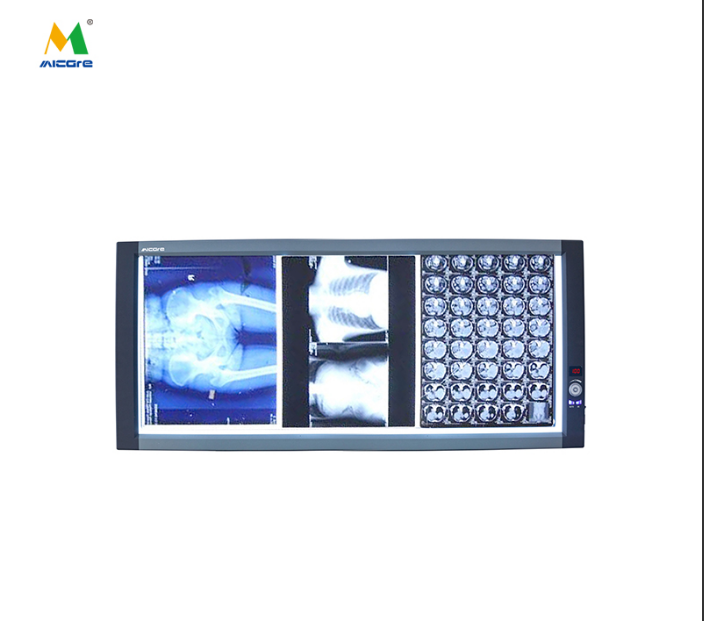สิ่งที่ทำให้ผู้ดูรังสีเอกซ์ทางการแพทย์ระดับวินิจฉัยแตกต่างจากพื้นฐานคืออะไร?
ระบบแสดงผลภาพเอ็กซ์เรย์ทางการแพทย์แบ่งออกเป็นสองประเภท ได้แก่ ระดับการวินิจฉัยและระดับพื้นฐาน ซึ่งส่งผลกระทบสำคัญต่อความแม่นยำในการปฏิบัติงานทางคลินิกพร้อมทั้งความรวดเร็วของกระบวนการทำงาน การเข้าใจอย่างถูกต้องเกี่ยวกับความแตกต่างเหล่านี้ ถือเป็นพื้นฐานสำคัญในการกำหนดข้อกำหนดของอุปกรณ์สำหรับแผนกเวชศาสตร์รังสี
ลักษณะสำคัญที่สุดที่แยกแยะคือมาตรฐานประสิทธิภาพความสว่าง ผู้ดูระดับวินิจฉัยจำเป็นต้องมีความสว่างมากกว่า 3,500 cd/m² เพื่อให้บุคลากรทางการแพทย์สามารถดูความหนาแน่นของภาพทั้งหมดในผลลัพธ์การถ่ายภาพรังสีได้อย่างเหมาะสม จอแสดงผลพื้นฐานมีความสว่างไม่เกิน 1,000-2,000 cd/m² ในขณะที่การวินิจฉัยทางคลินิกต้องการอย่างน้อย 3,500 cd/m² จอ MICARE สำหรับการวินิจฉัยให้การแสดงผลที่สว่างและชัดเจนถึง 4,000 cd/m² ตลอดพื้นที่มองเห็นทั้งหมด เกินกว่าข้อกำหนดพื้นฐาน
อุปกรณ์สำหรับใช้งานมืออาชีพจะแตกต่างจากตัวเลือกพื้นฐานเนื่องจากความสามารถในการปฏิบัติตามมาตรฐานความสม่ำเสมอ ผู้ตรวจสอบคุณภาพสามารถทำให้มีความแตกต่างของแสงน้อยกว่า 10% ทั่วทั้งพื้นที่การมองเห็น แต่อุปกรณ์ระดับเริ่มต้นอาจแสดงความแปรปรวนได้ถึง 20-30% การอ่านค่าความหนาแน่นเล็กๆ ที่ส่งสัญญาณถึงโรคขึ้นอยู่กับระบบในการรักษาความสว่างคงที่ในทุกส่วนของพื้นที่แสดงผล ความเชี่ยวชาญสูงในการวางตำแหน่ง LED ร่วมกับวิธีการกระจายแสงขั้นสูงมอบผลลัพธ์ความสม่ำเสมอเหล่านี้ในอุปกรณ์การถ่ายภาพทางการแพทย์
สถานีวินิจฉัยจำเป็นต้องปฏิบัติตามมาตรฐาน DICOM ตามข้อกำหนดที่บังคับใช้ ระบบได้นำเอาการาลิบรเอชันฟังก์ชันการแสดงผลมาตรฐานสเกลเทา (GSDF) มาใช้เพื่อแสดงความแตกต่างของความสว่างอย่างต่อเนื่องในช่วงสเกลเทา ผู้ดูพื้นฐานทำงานโดยไม่มีฟีเจอร์การคาลิเบรตในตัวซึ่งอาจก่อให้เกิดปัญหาในการแปลความหนาแน่นของภาพพร้อมทั้งอาจพลาดการค้นพบได้ ในผู้ดู MICARE ผู้ใช้สามารถตรวจสอบการยืนยันการคาลิเบรตได้โดยตรง เนื่องจากระบบทำการชดเชยแสงแวดล้อมอัตโนมัติ
แต่ละหมวดหมู่ของผู้ดูมีความแตกต่างพื้นฐานในคุณภาพของการก่อสร้าง:
- การวินิจฉัย: กรอบอะลูมิเนียมเกรดอากาศยานพร้อมกระจกทนแรง
- พื้นฐาน: ตัวเครื่องพลาสติกพร้อมแผงอะคริลิค
- การวินิจฉัย: ดีไซน์ปิดสนิท ป้องกันฝุ่น (ระดับ IP54)
- พื้นฐาน: ดีไซน์ระบายอากาศซึ่งอาจสะสมฝุ่นได้
ฟีเจอร์พิเศษที่พบเฉพาะในผู้ดูสำหรับการวินิจฉัย:
- เซนเซอร์แสงแวดล้อมสำหรับปรับความสว่างอัตโนมัติ
- แบบทดสอบความสม่ำเสมอที่บูรณาการ
- ระบบติดตามการรับประกันคุณภาพ
- เครื่องมือบำรุงรักษาการสอบเทียบ DICOM
ความทนทานและความต้องการในการบำรุงรักษายังแตกต่างกันอย่างมาก:
- การวินิจฉัย: หลอด LED เกรดทางการแพทย์ที่ใช้งานได้มากกว่า 50,000 ชั่วโมง
- พื้นฐาน: หลอดฟลูออเรสเซนต์เกรดเชิงพาณิชย์ที่ใช้งานได้ 10,000 ชั่วโมง
- การวินิจฉัย: เครื่องกำเนิดแสงที่สามารถเปลี่ยนได้ในสนาม
- พื้นฐาน: จำเป็นต้องเปลี่ยนหน่วยทั้งหมด
ผู้ชมสำหรับการวินิจฉัยที่ผลิตโดย MICARE ตอบสนองต่อมาตรฐานระหว่างประเทศทั้งหมดที่เกี่ยวข้องกับการแปลผลทางรังสีภาพตาม IEC 61223-2-5 และ AAPM TG18 โครงสร้างที่แข็งแรงของมันทำให้สามารถให้บริการศูนย์ทางการแพทย์ได้อย่างเต็มประสิทธิภาพตลอดหลายปี และความสามารถด้านออปติกที่ซับซ้อนช่วยลดความเสี่ยงของการพลาดข้อมูลสำคัญเนื่องจากข้อจำกัดของอุปกรณ์ สถานที่ทุกแห่งที่ทำการแปลผลระดับแรกของฟิล์มหรือเอกสารพิมพ์ดิจิทัลต้องลงทุนในผู้ชมเกรดการวินิจฉัยเพื่อรักษาการทำงานและการดูแลผู้ป่วยที่มีคุณภาพสูง











































